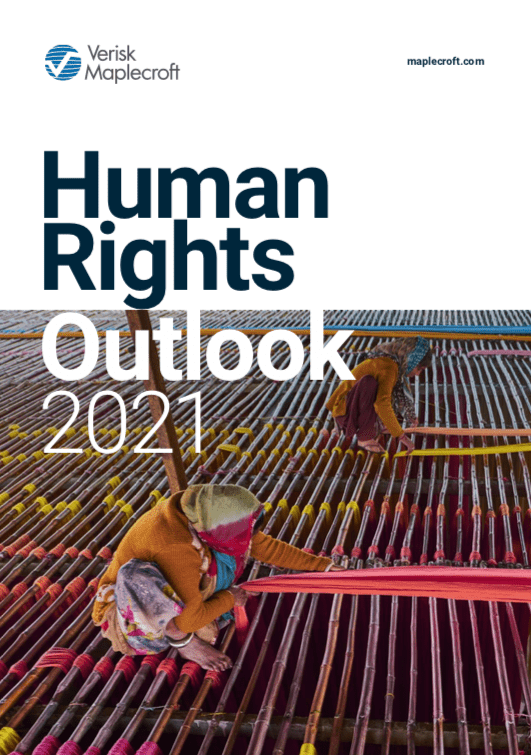
Human Rights Outlook 2021
Executive Summary
Human rights do not exist in a vacuum. They are subject to the vicissitudes of governments, to poorly enforced and ineffectual laws, and the ebb and flow of market forces. At no point in recent times have these factors coalesced more than over the last 18 months. Add in the indirect impacts of a global pandemic – which has upended working practices, thrown supply chains into turmoil and amplified inequalities – and a troubling shift in the human rights environment was inevitable.
For 20 years, our aim has been to develop innovative solutions that make a tangible difference to the lives of people and workers around the world by helping companies operate more responsibly. Our focus on data means we are unique in having the ability to assess the trajectory of the global human rights landscape. Using our risk indices, subnational issue mapping and ESG commodities data, we’ve taken stock of the trends, the current state of play, the cross-cutting issues driving risk, and how and where human rights are intersecting with the world of business and finance.
The picture that emerges is complex and concerning.
Labour rights on a global slide
Firstly, let’s take supply chains. Over the last 5 years, our labour rights indices show that modern slavery, child labour, discrimination, OHS and decent wages are just some of the issues that have seen a steady deterioration. We’re seeing these declines at a global level, but what’s notable is that they are worsening most where the bulk of global goods are manufactured.
For responsible sourcing departments, the challenge has no easy answers. For instance, a number of South East Asia’s primary manufacturing hubs have been downgraded to ‘extreme’ risk in our Modern Slavery Index. But as brands reassess their exposure to China, due to the forced labour practices taking place there, the irony is that these countries often constitute the only viable alternatives.
ESG credentials of 4 in 10 top cities for FDI in question
Zooming in to human rights at a more local level reveals an equally nuanced picture. Using our subnational human rights and poverty indices, we’ve evaluated the exposure of business and investors to a range of social risks in the world’s major cities.
We’ve found that the human rights of citizens in 40% of the globe’s top 100 locations for foreign direct investment (FDI) are at ‘high’ or ‘extreme’ risk, while overall, 75% of the 575 cities assessed also sit within the two highest risk categories. At a time when ethical investment is becoming more prominent, this brings into question the ESG credentials of a swathe of important commercial hubs that are home to some 1.4 billion people and at least one in every 10 dollars of FDI.
The S in ESG is about to hit the spotlight
Getting to grips with the S in ESG is going to be a particularly important theme for investors going forward. Under the Sustainable Finance Disclosure Regulation (SFDR), asset managers will soon need to report on human rights abuses in their sovereign portfolios, as well as explain how they address these abuses in any funds that they label sustainable.
Sovereign debt will be a key area of focus because governments are the ultimate guarantors of human and labour rights. But Brussels has set its sights on all asset classes. We explore how best to navigate this new reality and make real impact with a portfolio while minimising risk. The balance isn’t easy, but with the right inputs we think it’s achievable.
Nexus of risks tainting key commodities
The intersection of human rights, the destruction of natural capital and commodity production provides an important example of why corporates and investors can no longer look at risk in silos. Our analysis reveals clear links between land grabs and biodiversity loss; the poverty, corruption and weak rule of law that drive them; and how these issues enter our everyday lives.
Using our ESG data covering 170 hard and soft commodities, we identify the raw materials posing the highest risk of land grabs. What we’ve found is an outsized risk to indigenous peoples and natural habitats stemming from a surprising range of commodities that not only provide the food we eat, but also the materials needed to power the energy transition.
Separation of powers under threat in 25% of countries
Another key trend we are tracking is the interplay between political risk and human rights. A major battleground is the separation of powers.
Since 2017, our Judicial Independence Index has identified growing political interference in the legal systems of 45 countries. The consequences are double- edged. For companies in ‘high’ risk jurisdictions, this could mean a lack of recourse in contract renegotiations, or unfair legal sanctions imposed by governments to punish perceived slights or to achieve geopolitical aims. But it also undermines the protection of human rights by enabling states to pursue political opponents, activists and journalists with legal penalties, while removing access to remedy for victims of violations.
Final word
The issues covered here are not exhaustive, but they do show a direction of travel. It is difficult to say things are improving, but it is not all bad news. Investors have more opportunity to influence how governments and companies act than at any other time. The concept of ESG has gone mainstream and organisations are embracing the idea that managing these issues well will also drive better business performance. If matched by proactive efforts by lawmakers and regulators in key jurisdictions, this has the potential to achieve the more important aim of improving the lives of millions.
For now, understanding your risk is the first and most important step you can take. The rest will hopefully follow.
Read full report here.
Learn more about Verisk Maplecroft here.
